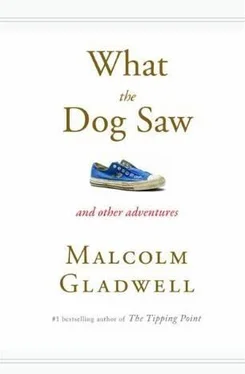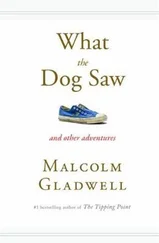Malcolm Gladwell - What the Dog Saw
Здесь есть возможность читать онлайн «Malcolm Gladwell - What the Dog Saw» весь текст электронной книги совершенно бесплатно (целиком полную версию без сокращений). В некоторых случаях можно слушать аудио, скачать через торрент в формате fb2 и присутствует краткое содержание. Город: New York, Год выпуска: 2009, ISBN: 2009, Издательство: Little, Brown and Company, Жанр: Психология, на английском языке. Описание произведения, (предисловие) а так же отзывы посетителей доступны на портале библиотеки ЛибКат.
- Название:What the Dog Saw
- Автор:
- Издательство:Little, Brown and Company
- Жанр:
- Год:2009
- Город:New York
- ISBN:978-0316075848
- Рейтинг книги:5 / 5. Голосов: 1
-
Избранное:Добавить в избранное
- Отзывы:
-
Ваша оценка:
- 100
- 1
- 2
- 3
- 4
- 5
What the Dog Saw: краткое содержание, описание и аннотация
Предлагаем к чтению аннотацию, описание, краткое содержание или предисловие (зависит от того, что написал сам автор книги «What the Dog Saw»). Если вы не нашли необходимую информацию о книге — напишите в комментариях, мы постараемся отыскать её.
What the Dog Saw — читать онлайн бесплатно полную книгу (весь текст) целиком
Ниже представлен текст книги, разбитый по страницам. Система сохранения места последней прочитанной страницы, позволяет с удобством читать онлайн бесплатно книгу «What the Dog Saw», без необходимости каждый раз заново искать на чём Вы остановились. Поставьте закладку, и сможете в любой момент перейти на страницу, на которой закончили чтение.
Интервал:
Закладка:
He held it in the air as if he were holding up a Tiffany vase. That’s where you find stories, in someone’s kitchen on the Jersey Shore.
4.
Growing up, I never wanted to be a writer. I wanted to be a lawyer, and then in my last year of college, I decided I wanted to be in advertising. I applied to eighteen advertising agencies in the city of Toronto and received eighteen rejection letters, which I taped in a row on my wall. (I still have them somewhere.) I thought about graduate school, but my grades weren’t quite good enough. I applied for a fellowship to go somewhere exotic for a year and was rejected. Writing was the thing I ended up doing by default, for the simple reason that it took me forever to realize that writing could be a job. Jobs were things that were serious and daunting. Writing was fun.
After college, I worked for six months at a little magazine in Indiana called the American Spectator. I moved to Washington, DC, and freelanced for a few years, and eventually caught on with the Washington Post —and from there came to The New Yorker . Along the way, writing has never ceased to be fun, and I hope that buoyant spirit is evident in these pieces. Nothing frustrates me more than someone who reads something of mine or anyone else’s and says, angrily, “I don’t buy it.” Why are they angry? Good writing does not succeed or fail on the strength of its ability to persuade. Not the kind of writing that you’ll find in this book, anyway. It succeeds or fails on the strength of its ability to engage you, to make you think, to give you a glimpse into someone else’s head—even if in the end you conclude that someone else’s head is not a place you’d really like to be. I’ve called these pieces adventures, because that’s what they are intended to be. Enjoy yourself.
PART ONE
Obsessives, Pioneers, and Other Varieties of Minor Genius
“To a worm in horseradish, the world is horseradish.”
The Pitchman
RON POPEIL AND THE CONQUEST OF THE AMERICAN KITCHEN
1.
The extraordinary story of the Ronco Showtime Rotisserie & BBQ begins with Nathan Morris, the son of the shoemaker and cantor Kidders Morris, who came over from the Old Country in the 1880s, and settled in Asbury Park, New Jersey. Nathan Morris was a pitchman. He worked the boardwalk and the five-and-dimes and county fairs up and down the Atlantic coast, selling kitchen gadgets made by Acme Metal, out of Newark. In the early forties, Nathan set up N. K. Morris Manufacturing—turning out the KwiKi-Pi and the Morris Metric Slicer—and perhaps because it was the Depression and job prospects were dim, or perhaps because Nathan Morris made such a compelling case for his new profession, one by one the members of his family followed him into the business. His sons Lester Morris and Arnold (the Knife) Morris became his pitchmen. He set up his brother- in-law Irving Rosenbloom, who was to make a fortune on Long Island in plastic goods, including a hand grater of such excellence that Nathan paid homage to it with his own Dutch Kitchen Shredder Grater. He partnered with his brother Al, whose own sons worked the boardwalk, alongside a gangly Irishman by the name of Ed McMahon. Then, one summer just before the war, Nathan took on as an apprentice his nephew Samuel Jacob Popeil. S.J., as he was known, was so inspired by his uncle Nathan that he went on to found Popeil Brothers, based in Chicago, and brought the world the Dial-O-Matic, the Chop-O-Matic, and the Veg-O-Matic. S. J. Popeil had two sons. The elder was Jerry, who died young. The younger is familiar to anyone who has ever watched an infomercial on late-night television. His name is Ron Popeil.
In the postwar years, many people made the kitchen their life’s work. There were the Klinghoffers of New York, one of whom, Leon, died tragically in 1985, during the Achille Lauro incident, when he was pushed overboard in his wheelchair by Palestinian terrorists. They made the Roto-Broil 400, back in the fifties, an early rotisserie for the home, which was pitched by Lester Morris. There was Lewis Salton, who escaped the Nazis with an English stamp from his father’s collection and parlayed it into an appliance factory in the Bronx. He brought the world the Salton Hotray—a sort of precursor to the microwave—and today Salton, Inc., sells the George Foreman Grill.
But no rival quite matched the Morris-Popeil clan. They were the first family of the American kitchen. They married beautiful women and made fortunes and stole ideas from one another and lay awake at night thinking of a way to chop an onion so that the only tears you shed were tears of joy. They believed that it was a mistake to separate product development from marketing, as most of their contemporaries did, because to them the two were indistinguishable: the object that sold best was the one that sold itself. They were spirited, brilliant men. And Ron Popeil was the most brilliant and spirited of them all. He was the family’s Joseph, exiled to the wilderness by his father only to come back and make more money than the rest of the family combined. He was a pioneer in taking the secrets of the boardwalk pitchmen to the television screen. And, of all the kitchen gadgets in the Morris-Popeil pantheon, nothing has ever been quite so ingenious in its design, or so broad in its appeal, or so perfectly representative of the Morris-Popeil belief in the interrelation of the pitch and the object being pitched, as the Ronco Showtime Rotisserie & BBQ, the countertop oven that can be bought for four payments of $39.95 and may be, dollar for dollar, the finest kitchen appliance ever made.
2.
Ron Popeil is a handsome man, thick through the chest and shoulders, with a leonine head and striking, oversize features. He is in his midsixties and lives in Beverly Hills, halfway up Coldwater Canyon, in a sprawling bungalow with a stand of avocado trees and a vegetable garden out back. In his habits Popeil is, by Beverly Hills standards, old school. He carries his own bags. He has been known to eat at Denny’s. He wears T-shirts and sweatpants. As often as twice a day, he can be found buying poultry or fish or meat at one of the local grocery stores—in particular Costco, which he favors because the chickens there are $0.99 a pound, as opposed to a $1.49 at standard supermarkets. Whatever he buys, he brings back to his kitchen, a vast room overlooking the canyon, with an array of industrial appliances, a collection of fifteen hundred bottles of olive oil, and, in the corner, an oil painting of him, his fourth wife, Robin (a former Frederick’s of Hollywood model), and their baby daughter, Contessa. On paper, Popeil owns a company called Ronco Inventions, which has two hundred employees and a couple of warehouses in Chatsworth, California, but the heart of Ronco is really Ron working out of his house, and many of the key players are really just friends of Ron’s who work out of their houses, too, and who gather in Ron’s kitchen when, every now and again, Ron cooks a soup and wants to talk things over.
In the last thirty years, Ron has invented a succession of kitchen gadgets, among them the Ronco Electric Food Dehydrator and the Popeil Automatic Pasta and Sausage Maker, which featured a thrust bearing made of the same material used in bulletproof glass. He works steadily, guided by flashes of inspiration. In August of 2000, for instance, he suddenly realized what product should follow the Showtime Rotisserie. He and his right-hand man, Alan Backus, had been working on a bread-and-batter machine, which would take up to ten pounds of chicken wings or scallops or shrimp or fish fillets and do all the work—combining the eggs, the flour, the breadcrumbs—in a few minutes, without dirtying either the cook’s hands or the machine. “Alan goes to Korea, where we have some big orders coming through,” Ron explained recently over lunch—a hamburger, medium-well, with fries—in the VIP booth by the door in the Polo Lounge, at the Beverly Hills Hotel. “I call Alan on the phone. I wake him up. It was two in the morning there. And these are my exact words: ‘Stop. Do not pursue the bread-and-batter machine. I will pick it up later. This other project needs to come first.’” The other project, his inspiration, was a device capable of smoking meats indoors without creating odors that can suffuse the air and permeate furniture. Ron had a version of the indoor smoker on his porch—“a Rube Goldberg kind of thing” that he’d worked on a year earlier—and, on a whim, he cooked a chicken in it. “That chicken was so good that I said to myself”—and with his left hand Ron began to pound on the table—“This is the best chicken sandwich I have ever had in my life.” He turned to me: “How many times have you had a smoked-turkey sandwich? Maybe you have a smoked-turkey or a smoked-chicken sandwich once every six months. Once! How many times have you had smoked salmon? Aah. More. I’m going to say you come across smoked salmon as an hors d’oeuvre or an entrée once every three months. Baby-back ribs? Depends on which restaurant you order ribs at. Smoked sausage, same thing. You touch on smoked food”—he leaned in and poked my arm for emphasis—“but I know one thing, Malcolm. You don’t have a smoker.”
Читать дальшеИнтервал:
Закладка:
Похожие книги на «What the Dog Saw»
Представляем Вашему вниманию похожие книги на «What the Dog Saw» списком для выбора. Мы отобрали схожую по названию и смыслу литературу в надежде предоставить читателям больше вариантов отыскать новые, интересные, ещё непрочитанные произведения.
Обсуждение, отзывы о книге «What the Dog Saw» и просто собственные мнения читателей. Оставьте ваши комментарии, напишите, что Вы думаете о произведении, его смысле или главных героях. Укажите что конкретно понравилось, а что нет, и почему Вы так считаете.











